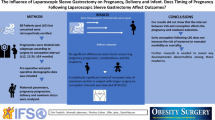Abstract
Background
Laparoscopic adjustable gastric banding (LAGB) is a proven method for weight reduction. Less is known about pregnancies in patients after LAGB.
Methods
Information was gathered, through database and survey, on women who underwent LAGB at NYU Medical Center between 2001 and 2008 then became pregnant.
Results
Pregnancy occurred in 133 women, resulting in 112 babies, including six sets of twins. The average pre-pregnancy body mass index (BMI) was 32.7. Average weight gain was 11.5 kg, but was higher for those with pre-pregnancy BMI <30.0 compared to BMI >30.0 (16.4 vs 8.6 kg). Of singleton pregnancies, 89% were carried to full term, with cesarean section in 45%. Those with pre-pregnancy BMI <30.0 had a lower rate of cesarean section (35.71%), but it was not statistically significant (p = 0.55). Average birth weight was 3,268.6 g. Eight percent of babies from singleton pregnancies were low birth weight (<2,500 g), and seven percent were high birth weight (>4,000 g). Average Apgar scores at 1 and 5 min were 8.89 and 9.17. Four percent of patients developed gestational diabetes, and 5% developed pre-eclampsia. Band adjustments were performed in 71% of patients. Weight gain was higher in those who had their bands loosened in the first trimester (p = 0.063). Three patients had intrapartum band slips; one required surgery during pregnancy.
Conclusions
LAGB is tolerable in pregnancy with rare intrapartum band slips. Weight gain is less in those with higher pre-pregnancy BMI and those who had their bands filled or not adjusted. Babies born to these mothers are as healthy as the general population.
Similar content being viewed by others
References
Hamilton BE, Martin JA, Venture SJ. Births: preliminary data for 2007. Natl Vital Stat Rep. 2009;57(12):1–23.
Martin JA, Hamilton BE, Sutton PD, et al. Births: final data for 2006. Natl Vital Stat Rep. 2009;57(7):1–102.
Thorsdottir I, Torfadottir JE, Birgisdottir BE, et al. Weight gain in women of normal weight before pregnancy: complications in pregnancy or delivery and birth outcome. Obstet Gyn. 2002;99(5):799–806.
Casey BM, McIntire DD, Leveno KJ. The continuing value of the APGAR score for the assessment of newborn infants. NEJM. 2001;344(7):467–71.
Cunningham FG, Leveno KL, Bloom SL, et al. Prenatal care. In: Cunningham FG, Leveno KL, Bloom SL, Hauth JC, Gilstrap LC, Wenstrom KD, eds. Williams’ obstetrics. 22nd edn. New York: McGraw Hill; 2005. Available at http://www.accessmedicine.com. Retrieved October 2, 2009.
Vital statistics of New York state 2007. New York State Department of Health. 2009. Available at http://www.health.state.ny.us/statistics. Retrieved October 1, 2009.
Linne Y. Effects of obesity on women's reproduction and complications during pregnancy. Obes Rev. 2004;5:137–43.
Ramsay JE, Greer IA. Obesity in pregnancy. Fetal Matern Med Rev. 2004;15(2):109–32.
Nuthalapaty FS, Rouse DJ. The impart of obesity on obstetrical practice and outcome. Clin Obstet Gyn. 2004;47(4):898–913.
Cedergren MI. Maternal morbid obesity and the risk of adverse pregnancy outcome. Obstet Gyn. 2004;103(2):219–24.
Weight gain during pregnancy: reexamining the guidelines. Rasmussen KM, Yaktine AL, eds. Institute of Medicine. Washington: National Academy of Sciences; 2009.
Biagini J, Karam L. Ten years experience with laparoscopic adjustable gastric banding. Obes Surg. 2008;18:673–7.
Parikh MS, Fielding GA, Ren CJ. U.S experience with 749 laparoscopic adjustable gastric bands: intermediate outcomes. Surg Endosc. 2005;19:1631–5.
Dietz PM, Callaghan WM, Morrow B, et al. Population-based assessment of the risk of primary cesarean delivery due to excess prepregnancy weight amount nulliparous women delivering term infants. Mat Child Health Jour. 2005;9(3):237–44.
Dixon JB, Dixon ME, O'Brien PE. Birth outcomes in obese women after laparoscopic adjustable gastric banding. Obstet Gyn. 2005;106(5–1):965–72.
Skull AJ, Slater GH, Duncombe JE, et al. Laparoscopic adjustable banding in pregnancy: safety, patient tolerance and effect on obesity-related pregnancy outcomes. Obes Surg. 2004;14:230–5.
Martin LF, Finigan KM, Nolan TE. Pregnancy after adjustable gastric banding. Obstet Gyn. 2000;95(6):927–30.
O'Brien PE, Dixon JB. Laparoscopic adjustable gastric banding in the treatment of morbid obesity. Arch Surg. 2003;138(4):376–82.
Slama R, Bouyer J, Windham G, et al. Influence of paternal age on the risk of spontaneous abortion. Am J Epi. 2005;161(9):816–23.
Acknowledgements
Drs. Ren, Fielding, and Kurian were the primary surgeons and completed follow-up visits postoperatively. Dr. Friedman, Mr. Lok, Ms. Youn, and Ms. Finger contributed to data collection. G. Craig Wood contributed to statistical analysis. Dr. Carelli contributed to data collection, analysis, and authorship of this manuscript. Dr. Ren had full access to all of the data in the study and takes responsibility for the integrity of the data and the accuracy of the data analysis.
Conflicts of interest
Drs. Ren, Fielding, and Kurian receive educational and research grants from Allergan and are on the advisory board; however, none were utilized for the purposes of this study. The remaining authors have nothing to disclose.
Author information
Authors and Affiliations
Corresponding author
Rights and permissions
About this article
Cite this article
Carelli, A.M., Ren, C.J., Youn, H.A. et al. Impact of Laparoscopic Adjustable Gastric Banding on Pregnancy, Maternal Weight, and Neonatal Health. OBES SURG 21, 1552–1558 (2011). https://doi.org/10.1007/s11695-010-0265-1
Published:
Issue Date:
DOI: https://doi.org/10.1007/s11695-010-0265-1



